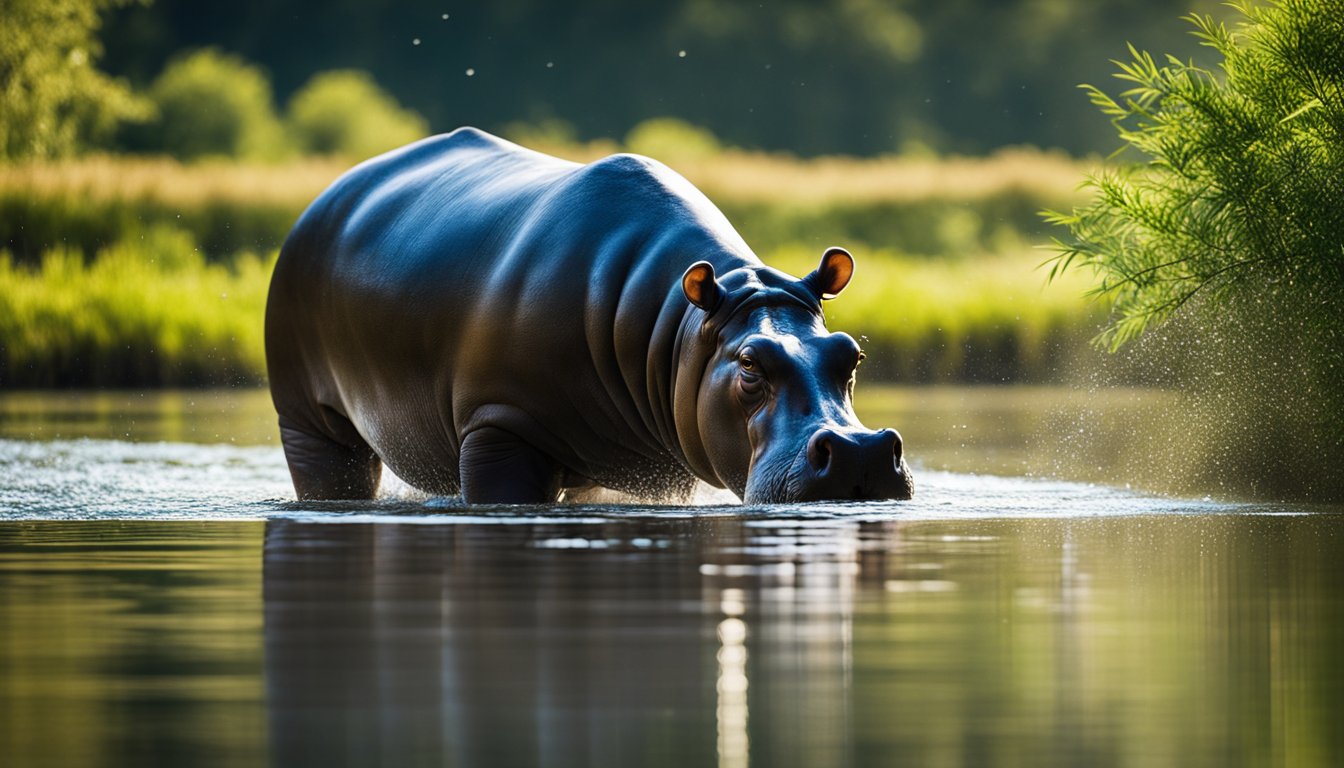Have you ever seen a hippopotamus, or a hippo, as we often call them? These huge creatures are really fascinating!
We find them in the rivers and lakes of Africa, and they are one of Earth’s largest mammals.
Even though hippos might look like giant, lazy animals, they’re quite fast in the water and can be surprisingly speedy on land too!
But don’t let their playful looks deceive you; hippos are actually pretty powerful and are known to protect their space in the water with a lot of energy.

Hippos spend most of their day chilling in the water, which helps keep their massive bodies cool under the hot African sun.
We call them ‘semi-aquatic’ because their lives are split between land and water.
Even though they’re big, they have special bodies that let them glide through the water with ease.
Did you know that hippos can even sleep underwater?
They come up to breathe without waking up. How cool is that?
The name ‘hippopotamus’ comes from ancient Greek words that mean ‘river horse,’ and when you watch hippos yawning big in the water, they sort of remind us of how a horse might look if it lived in a river!
Despite being so hefty, hippos can be quite graceful, especially when they ‘dance’ through the water.
They’re also known for their enormous mouths, which they can open really wide to show their teeth.
That’s their way of saying, ‘This is my space!’ Now, let’s wade into the world of hippos and discover even more fantastic facts about these giant river horses.
Exploring the Hippo’s Habitat

Hey there, curious friends! Let’s take a magical mini-journey into the world where our hefty hippo pals spend their days and nights.
From splashing in cool rivers to munching on yummy grasses, we’re going to discover some fascinating places that hippos call home!
Splash Into the Water World
Hippos love water!
These magnificent mammals spend up to 16 hours each day in lakes and rivers to keep their huge bodies cool under the hot African sun.
Even though they’re so big, hippos are known as semi-aquatic because their lives are split between water and land.
In water, they can hold their breath for about five minutes and even sleep underwater, coming up to breathe without waking up.
Neat, right?
On Land Adventures
When night falls, hippos go on a snack quest, leaving the comfort of their watery wonderland. They travel on paths to find their favorite food—grasses.
Did you know hippos are herbivores? That means they only eat plants, and boy, do they eat a lot—up to 88 pounds of grass each night!
Despite looking a bit like a large barrel with legs, they can quickly run but only for short distances.
Where in the World Is the Hippo?
Our hippo friends live in Sub-Saharan Africa, an area south of the Sahara desert where the sun loves to sizzle.
They prefer living near rivers and lakes, where they can play hide and seek underwater.
Some hippos face tough times because their habitats are in danger, making them an endangered species.
By protecting rivers and lakes in Africa, we can make sure hippos have a happy home for generations to come.
Hippos: Giants of the Wild

Let’s take an exciting look into the lives of hippos, the massive creatures that wander the wilds of Africa!
We’re going to talk about their family life, what they munch on, and some really cool features they have.
Hippo Family Life
Hippos are quite social! A group of hippos is called a bloat, and they like to spend lots of time together in rivers and lakes.
Typically, a bloat is made up of a few female hippos and their calves, with one male taking charge.
Baby hippos, or calves, stay close to their moms for protection and learn how to swim at a very young age.
The gestation period for a female hippo is about 8 months; that’s how long a little calf grows inside its mom before being born.
What Does a Hippo Eat?
Even though they’re so big, hippos are mostly herbivores. This means they like to eat plants, especially grasses.
When they feed at dusk, they may travel far on land, munching on grass. A grown hippo can eat about 88 pounds of grass in one night!
Their feeding habits are pretty neat—they have special lips that help pull the grass into their mouth.
Fun Facts About Hippo Features
Have you ever seen a hippo’s mouth? They can open their mouths super wide—about 150 degrees wide!
Their teeth are big and strong, too.
Hippos use their wide mouths to show off and scare away others that might be trying to cause trouble.
Their skin is another feature that’s really interesting.
It’s super thick to protect them, but it can get sunburned, which is why they hang out in the water so much.
Plus, they have a built-in sunscreen—kind of!
Their bodies make a special red liquid that keeps their skin moist and safe from the sun.
Let’s talk about their bodies:
- Eyes, ears, and nostrils on the top of their heads let them breathe and look around while staying mostly underwater.
- Just like you and me, hippos have to hold their breath underwater!
They can do so for about 30 minutes.
- Hippos can bebop in the water really well. They can even walk on the bottom of a river like it’s no big deal.
- Even though they’re huge—males can weigh up to 3.2 metric tonnes (or 3,500 pounds)—hippos can run fast, up to 30 km/h (19 mph) on land!
Hippos are one of the largest land mammals, with the scientific name Hippopotamus amphibius.
There are two kinds: the common hippo and the much smaller pygmy hippo.
But both are super cool and important to our world.










Add Comment